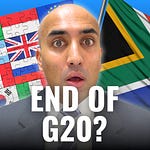WHAT IS IN TODAY’S INSIGHT?
Quick Read
New Domestic Tech
New Global Tech
Disrupted Geostrategy
Actionable Takeaways
INTRODUCTION
Ever since the Ukraine war began, Russia’s place and position in the world has become “fluid.”
At one moment, the world is fretting about Russia changing its nuclear doctrine, requiring the world to think about Putin’s shifting outlook. At another moment, the International Monetary Fund (IMF) resumed and then canceled dialogue with Moscow, reflecting the unshakeable resistance in the West towards any new “dealings” with Russia.
But as Russia’s security posture changes or its energy exports are rerouted, there is one area where Moscow has been quietly moving forward, even before the Ukraine war, with no U-turns or exceptions: technology.
The situation outside Russia’s borders is not disrupting Russia’s plans from software to hardware. In fact, at times, what is taking place in the globe is complementing Russia’s technology plans.
The development and spread of Russian software and hardware is not mainly commercial or economic, like, say, with American technology (i.e. Netflix, Amazon). Russia’s advances in technology revolve heavily around geopolitics.
Wherever Russian technology is present, geopolitics will be too.
And, the outcome of what Russia is doing with technology could be a “Digital Iron Curtain.” This is a concept first proposed in my book “The World Is Vertical,” where I discussed how technology and ideology could converge in the form of walls and barriers around the world.
Geopolitics and technology are once again merging, unleashing disruption on the world stage, in this case, how the West sanctions and squeezes the Russian bear.
1. QUICK READ (5 KEY POINTS)
Russia is moving forward with technology in a way that could disrupt Western geopolitical plans.
From domestic to global, from software to hardware, Russia has several projects underway that could separate Russia from the rest of the world, fragmenting the globe.
The outcome of many of the Russian projects is a “Digital Iron Curtain,” that limits how the West can deal with Russia.
What Russia is doing could inspire other nations, also in the Western crosshairs, to do the same and start using technology to redesign their geopolitical power
A new kind of Sino-Russian alliance is forming around technology that has gone under the radar of most, and this points to the “limitless” nature of the relationship between Russia and China.
2. NEW DOMESTIC TECH
There are two main ways that Russia is approaching technology: domestic and global.
Domestically, Russia is attempting to eject the West from its society with technology.
For example, the Kremlin is exploring a deal to purchase 2 million phones loaded with Aurora OS, a locally-developed mobile OS, over the next 36 months. Already, around 400,000 devices in Russia use Aurora. The Russian software was developed by Rostelecom, the largest telecom company in Russia.
Now, as Aurora OS matures, the Russian government is proposing to charge firms that use foreign software. The goal here is to begin pushing Russia, beyond the state, onto local software, like Aurora.
The Aurora OS is based on Linux, making it an open-source software push.
And, further drawing the world of open source technology into geopolitics, as RISC-V, a Western-developed open-source chip, is increasingly in the Western crosshairs as China shows interest.
While some might question the difficulty of loading up Russian society with a locally-developed mobile OS, it might be easier post-war than pre-war. Before the Ukraine war started, Apple and Samsung jointly controlled 53% of the Russian smartphone market. Today, they account for just 3%, as Chinese brands control 95% of the market.
Russia could build on its deepening relationship with China, and seek to have Chinese handsets in Russia use Aurora. Add to this, in 2019, Huawei was exploring Aurora OS loaded on the Chinese-branded phones, as a way to combat Western sanctions.
Strangely, the US and Russia are moving in similar ways.
The US is attempting to ban software (and hardware) from China and Russia in vehicles in the US, meaning Chinese vehicles could be effectively banned in America, to bolster national security. For Russia, it is also trying to bolster national security by phasing out Western software already in its borders. The US and Russia, clear adversaries, are doing the same thing: viewing software through the lens of geopolitics.
In the process, Russian software, deployed and developed out of geopolitics, will further separate Russia from the rest of the world, especially the West. It will serve as a barrier, a Digital Iron Curtain, imposed by the state, in a bid to “protect” Russia from external politics.
And AuroraOS is not the only domestic technology project Russia is working on, although it might be the most significant. Separately, Russia has developed “M-OS,” also based on Linux, to be deployed at Russian schools. Separately, Russia is building its own video game engine, a calculated move to build sovereignty in a sector that is rapidly growing, and where nations like Saudi Arabia are seeking leadership. And, alongside all this, is Russia’s infamous sovereign-internet project, a project that was unveiled before the war, and which many should have seen as a “sign” that Moscow was preparing for something big.
And while some might say that Russian software can never take off in mainstream society because the smartphones that dominate Russia are mainly Western, think again.
For Russia, it could be “easier” to have Chinese firms comply and load Aurora OS, considering the deepening integration between Moscow and Beijing.
3. NEW GLOBAL TECH
While Russia takes these steps within its borders, it is taking a different set of steps outside of its borders, which will establish a different Digital Iron Curtain in parts of the world.
Russia has unveiled plans to sell satellites to Mali, Niger, and Burkina Faso, three countries in West Africa that have come together under a new geopolitical bloc. While the world looks at SpaceX or BeiDou, Russia is also building inroads in the developing world with space technology. In the case of West African nations, Russia is becoming the foundation they stand on, to access space, in this case, satellites for telecommunications.
In the process, they are indirectly picking sides, standing in the Russian-orbit through technology. And by doing so, they may not stand with those nations outside of the Russian sphere of influence, meaning the Russian satellites could act as a new demarcation line between where Russia dominates, and where somebody else dominates.
Separately, a new report has revealed a secret Russian project underway in China to develop advanced military drones. One of the drones developed, referred to as “Garpiya-3 (G3),” is to be deployed to the Ukrainian theatre. Surprisingly, Russia developed the drones with the help of “local specialists,” meaning Chinese military engineers.
This not only takes China’s support for Moscow to new heights, but it also means that Russia is relying on China like never before, its own geopolitical can of worms.
And for anybody concerned about a Digital Iron Curtain, this kind of deep integration between Moscow and Beijing should be the most frightening. Because the technologies that Russia and China build together are unlikely to be used purely domestically, but will also be pushed onto the world, in a bid to roll the West back. Could G3 be sold to other nations? What else are Russia and China working on, from AI to chips, that could disrupt the West’s control over the globe?
A separate move, that blurs the lines between domestic and global, is crypto.
Russia is moving forward with a bold project to begin settling international trade with cryptocurrencies, a way to move beyond Western currencies and financial systems.
In July, Russia legalized the use of crypto by Russian businesses in cross-border transactions. Now, Russia is establishing new crypto exchanges, and on September 1, began trials for settling trade in crypto, including stablecoins around Yuan and even a BRICS currency.
There is much grey as to how this will work, including legality and regulations. Already, the US has sanctioned Russian crypto exchanges over ransomware attacks, a potential sign that Washington is aware of the risk Russia’s crypto ideas pose to evading American sanctions.
But the reality is that Russia is moving forward with settling global trade, from energy to raw materials, in non-traditional currencies, will further separate Russia from the “global system.” The more the Russian economy uses crypto, the more many will feel Russia’s economy is acting differently to everybody else, reinforcing the idea of a Digital Iron Curtain rising over Russia.
4. DISRUPTED GEOSTRATEGY
What Russia is doing with technology, which goes beyond just software localization or foreign projects, could force the West to rethink its broader strategy towards Moscow and other Western adversaries.
First, the West might be creating a new enemy for itself.
What Russia creates with technology, could end up being exported to the whole world, including other groups the West is trying to tackle. Already, Russia is in talks with Iran to send anti-ship missiles to the Houthis in Yemen. In the future, could it be drones next, like G3? Or, might Russia export its crypto-systems to Venezuela?
This is going to create a new headache for Western capitals, as Russia opens the door to sending its newly-developed technology to foreign lands, technology that was developed to combat the West itself.
Second, Western geopolitics appears to be pulling Russia and China closer together.
The fact that Russia is tapping Chinese specialists to develop an advanced military drone. Or, the fact that China is allowing this to occur within its own borders, shows how deep the Sino-Russian relationship has become. This is no longer just about energy or blocs. This is truly about shoring each other up in the face of global threats. And, it also creates serious doubts about China’s steps to limit exports to Russia, from Yuan to chips.
Third, what Russia is establishing, like software localization, could give rise to other localization drives.
And those drives might build new Russian economic sectors that are out of Western hands. What is taking place with Russia’s Lada brand opening an assembly line in Ethiopia to build cars for the African continent is an example of this. Because of the war, Lada is going beyond the Russian or former Soviet bloc. It is entering new markets on the back of geopolitics, where the West does not call the shots.
Fourth, the speed at which Russia is moving forward is unprecedented.
For years, Russia was vehemently opposed to crypto. Then, in a few months, it legalized it and began experimenting with it in cross-border trade. Geopolitics is driving technology projects at light speed, as countries view technology as one of the surest and most powerful ways to deal with the actions of their adversary.
Fifth, and lastly, the Russian moves with cryptocurrency make it clear that Moscow is quickly establishing a loosely-regulated dual financial system.
This mouthful of words, essentially means that to respond to Western geopolitics, Russia is establishing a parallel economy. In the case of crypto, Russia is giving birth to a new trade mechanism that will work alongside FIAT-based trading, not replace it. At a time when there are already heightened fears of a BRICS currency, it could be a Russian-crypto trading system that disrupts parts of the global economy out of the blue.
5. ACTIONABLE TAKEAWAYS
A new Russia is forming on the world stage. The limits on Russia imposed after the Ukraine war began are no longer restricting or confining Moscow as they once were. With technology, Russia is redefining its role, including in the global economy, unleashing a new kind of Russian trade and commerce with the entire world.
Preemptive moves are the new North Star. Existing playbooks to deal with geopolitics no longer work. Countries have to move preemptively, striking their adversaries economically before certain projects mature and become unstoppable. This applies to a range of nations the West is going after from Russia to China.
Tech companies need a geopolitical strategy. The world of technology is being drawn into geopolitics at a rapid speed. Every aspect of the technology world, from product design to talent procurement to supply chain, is being disrupted by the world stage. Without a geopolitical strategy, technology companies risk being “pulled apart.”
CONCLUSION
As Russia moves forward with technology, it is not explicitly calling for a Digital Iron Curtain. But if one looks at the end result of the projects Russia is working on, it is essentially a separation between Russia and the Western-world. With technology, Russia is establishing new walls and barriers between itself and governments like the US and EU.
In the process, the West may have a tougher and tougher time dealing with the Russian geopolitics, which is increasingly becoming bolder and more radical, especially in regard to Ukraine. Of course, this means that the West may be prompted to respond to Russia’s technology moves preemptively, to thwart what Moscow is working on.
Could this mean lobbying certain US allies to ban Russian software (i.e. Aurora)? Or does it mean restricting Western defense exports to nations that employ next-generation Russian military hardware (i.e. G3)?
While it was the West in the offensive mode when the war began, now it is the West in the reactive mode, as Russia’s technology projects are revealed or begin to gather some momentum.
All of this signals that technology is quickly changing geopolitical calculations and possibilities. And, on the back of geopolitics, technology is breaking up the world into camps, driving the vertical world.
The big question in front of Russia is whether it can sustain and accelerate its technology projects in real ways. For it to be effective, what Russia is working on cannot simply be rhetoric from the Kremlin. It must actually move Russia onto a new technology axis.
But the bigger question for the West is how it plans to deal with Russia going beyond Western rules and limits. Either, the West will have to live with the new Russian footprint, underpinned by technology. Or, in a bid to stop Russia, and anyone else who is thinking similar to Moscow, the West might have to clash with a range of nations, including China and India.
As Russia establishes a Digital Iron Curtain, it could generate a new fight on the world stage between the West, which wants to keep a certain status quo with technology, and other nations who are seeking a new status quo with those same technologies. Perhaps then, the biggest revelation in what Russia is doing is that technology is a double-edged sword, driving success at one moment and then cutting deeply at the next.
Want to republish this insight? Let’s talk: abishur@mrgeopolitics.com
If you like Mr. Geopolitics, your colleagues might too.
Feel like doing something unique for somebody important?











